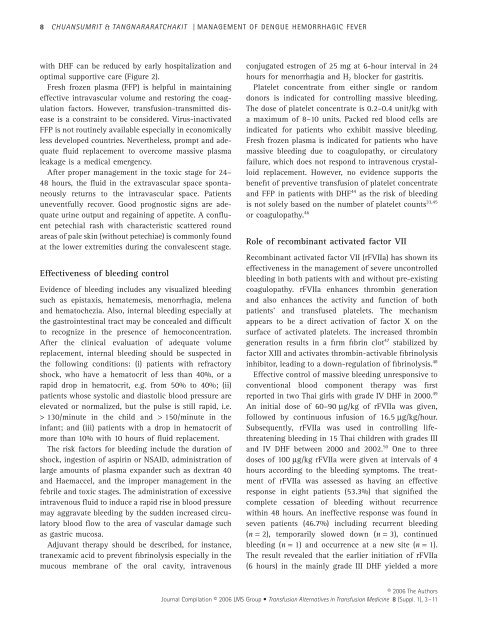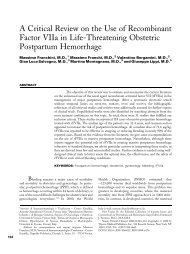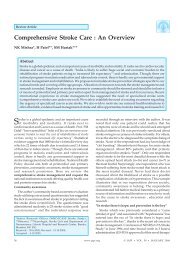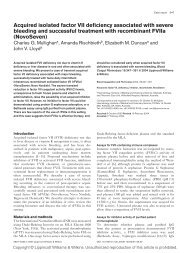Pathophysiology and management of dengue hemorrhagic fever
Pathophysiology and management of dengue hemorrhagic fever
Pathophysiology and management of dengue hemorrhagic fever
Create successful ePaper yourself
Turn your PDF publications into a flip-book with our unique Google optimized e-Paper software.
8 CHUANSUMRIT & TANGNARARATCHAKIT | MANAGEMENT OF DENGUE HEMORRHAGIC FEVER<br />
with DHF can be reduced by early hospitalization <strong>and</strong><br />
optimal supportive care (Figure 2).<br />
Fresh frozen plasma (FFP) is helpful in maintaining<br />
effective intravascular volume <strong>and</strong> restoring the coagulation<br />
factors. However, transfusion-transmitted disease<br />
is a constraint to be considered. Virus-inactivated<br />
FFP is not routinely available especially in economically<br />
less developed countries. Nevertheless, prompt <strong>and</strong> adequate<br />
fluid replacement to overcome massive plasma<br />
leakage is a medical emergency.<br />
After proper <strong>management</strong> in the toxic stage for 24–<br />
48 hours, the fluid in the extravascular space spontaneously<br />
returns to the intravascular space. Patients<br />
uneventfully recover. Good prognostic signs are adequate<br />
urine output <strong>and</strong> regaining <strong>of</strong> appetite. A confluent<br />
petechial rash with characteristic scattered round<br />
areas <strong>of</strong> pale skin (without petechiae) is commonly found<br />
at the lower extremities during the convalescent stage.<br />
Effectiveness <strong>of</strong> bleeding control<br />
Evidence <strong>of</strong> bleeding includes any visualized bleeding<br />
such as epistaxis, hematemesis, menorrhagia, melena<br />
<strong>and</strong> hematochezia. Also, internal bleeding especially at<br />
the gastrointestinal tract may be concealed <strong>and</strong> difficult<br />
to recognize in the presence <strong>of</strong> hemoconcentration.<br />
After the clinical evaluation <strong>of</strong> adequate volume<br />
replacement, internal bleeding should be suspected in<br />
the following conditions: (i) patients with refractory<br />
shock, who have a hematocrit <strong>of</strong> less than 40%, or a<br />
rapid drop in hematocrit, e.g. from 50% to 40%; (ii)<br />
patients whose systolic <strong>and</strong> diastolic blood pressure are<br />
elevated or normalized, but the pulse is still rapid, i.e.<br />
> 130/minute in the child <strong>and</strong> > 150/minute in the<br />
infant; <strong>and</strong> (iii) patients with a drop in hematocrit <strong>of</strong><br />
more than 10% with 10 hours <strong>of</strong> fluid replacement.<br />
The risk factors for bleeding include the duration <strong>of</strong><br />
shock, ingestion <strong>of</strong> aspirin or NSAID, administration <strong>of</strong><br />
large amounts <strong>of</strong> plasma exp<strong>and</strong>er such as dextran 40<br />
<strong>and</strong> Haemaccel, <strong>and</strong> the improper <strong>management</strong> in the<br />
febrile <strong>and</strong> toxic stages. The administration <strong>of</strong> excessive<br />
intravenous fluid to induce a rapid rise in blood pressure<br />
may aggravate bleeding by the sudden increased circulatory<br />
blood flow to the area <strong>of</strong> vascular damage such<br />
as gastric mucosa.<br />
Adjuvant therapy should be described, for instance,<br />
tranexamic acid to prevent fibrinolysis especially in the<br />
mucous membrane <strong>of</strong> the oral cavity, intravenous<br />
conjugated estrogen <strong>of</strong> 25 mg at 6-hour interval in 24<br />
hours for menorrhagia <strong>and</strong> H 2 blocker for gastritis.<br />
Platelet concentrate from either single or r<strong>and</strong>om<br />
donors is indicated for controlling massive bleeding.<br />
The dose <strong>of</strong> platelet concentrate is 0.2–0.4 unit/kg with<br />
a maximum <strong>of</strong> 8–10 units. Packed red blood cells are<br />
indicated for patients who exhibit massive bleeding.<br />
Fresh frozen plasma is indicated for patients who have<br />
massive bleeding due to coagulopathy, or circulatory<br />
failure, which does not respond to intravenous crystalloid<br />
replacement. However, no evidence supports the<br />
benefit <strong>of</strong> preventive transfusion <strong>of</strong> platelet concentrate<br />
<strong>and</strong> FFP in patients with DHF 44 as the risk <strong>of</strong> bleeding<br />
is not solely based on the number <strong>of</strong> platelet counts 33,45<br />
or coagulopathy. 46<br />
Role <strong>of</strong> recombinant activated factor VII<br />
Recombinant activated factor VII (rFVIIa) has shown its<br />
effectiveness in the <strong>management</strong> <strong>of</strong> severe uncontrolled<br />
bleeding in both patients with <strong>and</strong> without pre-existing<br />
coagulopathy. rFVIIa enhances thrombin generation<br />
<strong>and</strong> also enhances the activity <strong>and</strong> function <strong>of</strong> both<br />
patients’ <strong>and</strong> transfused platelets. The mechanism<br />
appears to be a direct activation <strong>of</strong> factor X on the<br />
surface <strong>of</strong> activated platelets. The increased thrombin<br />
generation results in a firm fibrin clot 47 stabilized by<br />
factor XIII <strong>and</strong> activates thrombin-activable fibrinolysis<br />
inhibitor, leading to a down-regulation <strong>of</strong> fibrinolysis. 48<br />
Effective control <strong>of</strong> massive bleeding unresponsive to<br />
conventional blood component therapy was first<br />
reported in two Thai girls with grade IV DHF in 2000. 49<br />
An initial dose <strong>of</strong> 60–90 µg/kg <strong>of</strong> rFVIIa was given,<br />
followed by continuous infusion <strong>of</strong> 16.5 µg/kg/hour.<br />
Subsequently, rFVIIa was used in controlling lifethreatening<br />
bleeding in 15 Thai children with grades III<br />
<strong>and</strong> IV DHF between 2000 <strong>and</strong> 2002. 50 One to three<br />
doses <strong>of</strong> 100 µg/kg rFVIIa were given at intervals <strong>of</strong> 4<br />
hours according to the bleeding symptoms. The treatment<br />
<strong>of</strong> rFVIIa was assessed as having an effective<br />
response in eight patients (53.3%) that signified the<br />
complete cessation <strong>of</strong> bleeding without recurrence<br />
within 48 hours. An ineffective response was found in<br />
seven patients (46.7%) including recurrent bleeding<br />
(n = 2), temporarily slowed down (n = 3), continued<br />
bleeding (n = 1) <strong>and</strong> occurrence at a new site (n = 1).<br />
The result revealed that the earlier initiation <strong>of</strong> rFVIIa<br />
(6 hours) in the mainly grade III DHF yielded a more<br />
© 2006 The Authors<br />
Journal Compilation © 2006 LMS Group • Transfusion Alternatives in Transfusion Medicine 8 (Suppl. 1), 3–11





